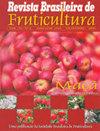Doses and intervals of application of potassium phosphite for the control of passion fruit scab
IF 0.9
4区 农林科学
Q4 HORTICULTURE
引用次数: 0
Abstract
Abstract Passion fruit scab (PFS), which is caused by species of the fungal complex Cladosporium cladosporioides, occurs both in protected environments and in the field. In view of the importance of the passion fruit scab, this study aimed to evaluate the effect of different intervals and doses of potassium phosphite in the greenhouse and in the field on the incidence of the disease. To evaluate the best dose of potassium phosphite, three experiments were carried out, two in a greenhouse and one in the field. The best application interval was evaluated in another experiment in a greenhouse. The variables evaluated were the incidence of plants with PFS symptoms (%) and the incidence of defoliated plants (%) in all experiments. The harvested fruits were evaluated for their mass (g), diameter (cm), soluble solids, acidity and chlorophyll content. The present work allowed to conclude that the dose of 0.1% of potassium phosphite was the best to control the passion fruit scab in a greenhouse, the treatment with an interval of 28 days of application showed a lower incidence of scab in seedlings at 35 days after inoculation and that potassium phosphite did not interfere in the quality parameters of fruits and leaves of passion fruit evaluated.亚磷酸钾防治百香果赤霉病的施用剂量和施用间隔
摘要百香果结痂(PFS)是由一种真菌复合体Cladosporium cladosporioides引起的,既发生在保护环境中,也发生在田间。鉴于百香果赤霉病的重要性,本研究旨在评价温室和田间不同时间间隔和剂量的亚磷酸钾对百香果赤霉病发病率的影响。为评价亚磷酸钾的最佳施用剂量,进行了2个温室试验和1个田间试验。在另一温室试验中评价了最佳施用间隔期。评估的变量是所有实验中出现PFS症状的植物发生率(%)和落叶植物发生率(%)。对收获的果实进行质量(g)、直径(cm)、可溶性固形物、酸度和叶绿素含量的评价。结果表明,在温室内施用0.1%的亚磷酸钾对百香果赤霉病的防治效果最好,间隔施用28 d的处理在接种35 d时,百香果赤霉病的发生率较低,且亚磷酸钾对百香果果实和叶片的质量参数评价没有影响。
本文章由计算机程序翻译,如有差异,请以英文原文为准。
求助全文
约1分钟内获得全文
求助全文
来源期刊
CiteScore
1.50
自引率
20.00%
发文量
34
审稿时长
4-8 weeks
期刊介绍:
The Revista Brasileira de Fruticultura (RBF) publishes technical articles and scientific communications in the area of fruit crops, referring to results of original searches and unpublished papers in Portuguese, Spanish or English, and 1 or 2 reviews per edition, of invited authors.

 求助内容:
求助内容: 应助结果提醒方式:
应助结果提醒方式:


